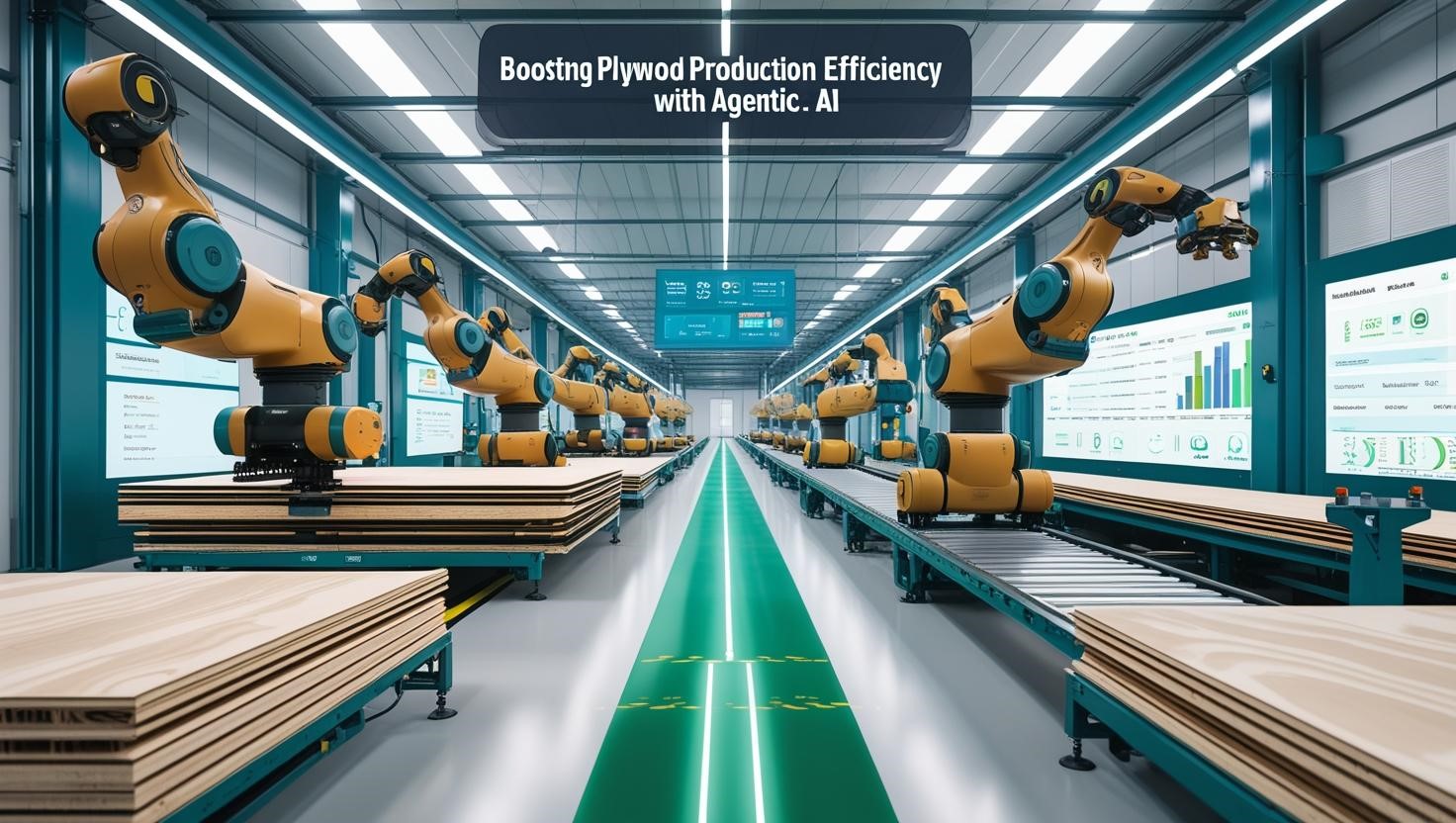Plywood manufacturing is not what it used to be. As the time increases and the cost increases, the industry faces increasing challenges: unexpected supply chains, increasing demand for adaptation, shortage of raw materials and shortage of labor. These factors are motivating the manufacturers to reconsider how they work. While traditional automation and ERP systems have helped to streamline the workflows and monitor the operation, they often lack the agility necessary to respond to real -time disruption. When the machinery goes down, supply shipment is delayed, or customer orders change at the last minute, these systems simply aren’t built to adapt dynamically.
Enter agent AI,a powerful development in artificial intelligence designed to work with autonomy, intelligence and adaptability. It is not only about changing manual functions; It is about empowering your production lines to think, learn and work independently. These systems bring intelligent, real -time decision -making ability that reduce downtime, reduce waste, and respond to changes with accuracy. Plywood manufacturing AI represents a seismic change in the functioning of factories. Imagine a system that automatically re -combines functions when an obstacle is detected, forecasting demand with high accuracy, and dynamically optimizes physical use with zero waste. These are no longer the ideal of the future – they are the tangible solutions being implemented today. In this blog, we will find out how the agent AI agency can combine AI in plywood production with expertise, can help manufacturers to reduce waste, adapt production and conduct more responsible operations that are ahead of the curve.
What Is Agentic AI?
Traditional AI just follows fixed rules and pre-programmed steps, but Agentic AI works in a smarter, more flexible way. At its core are autonomous software systems—referred to as agents—that continuously observe their environment, learn from outcomes, and make decisions without human intervention. These agents function independently or in coordination, adjusting their behavior to meet objectives in real time.
Imagine each agent as a digital brain handling a different part of your factory,one takes care of drying schedules, another manages another handling predictive maintenance, another managing inventory and supplier coordination, and yet another fine-tuning energy usage. The beauty of agentic AI lies in its collaborative nature—these agents can communicate with each other, share insights, and dynamically adjust strategies to maximize overall plant performance.
Let’s take an example, if an agent detects a shortage in raw materials, it can immediately signal other agents to adjust production targets, reorder supplies, or even reallocate resources to higher-priority tasks. It’s like giving your factory a team of AI-powered assistants that never sleep, never make emotional decisions, and never overlook critical data.
What’s more, these agents don’t simply respond, they take initiative They can anticipate maintenance needs before breakdowns occur, simulate various production scenarios, and even predict customer demand trends using real-time data. By embedding such intelligent adaptability at every level of the manufacturing process, Plywood manufacturing AI offers a robust foundation for true smart factory transformation.
Challenges Plywood Manufacturers Face Today
Managing a plywood factory means juggling countless moving parts, keeping everything running smoothly is a constant challenge, As the market evolves and customer expectations increase, manufacturers are facing mounting operational and strategic challenges that threaten their bottom line.
Some of the most common hurdles include:
Old-school scheduling systems can’t keep up with real-time changes—most traditional ERP or planning tools don’t adjust on the fly or predict what’s coming next. They may work well under stable conditions but fail to adapt when unforeseen disruptions, such as sudden order changes or machine failures occur.
High downtime due to unexpected equipment issues:
Most factories still wait for equipment to break before fixing it. When key machinery like peelers, dryers, or presses break down, production grinds to a halt. These unplanned downtimes not only lead to delivery delays but also result in higher repair costs and lost productivity.
Raw material shortages or delivery delays:
If your wood and glue supplies come late because of shipping problems, good luck keeping your production line on schedule. When shipments are delayed or incomplete, manufacturers are forced to either halt production or scramble for expensive alternatives.
Lack of supply chain transparency:
Most plants can’t track shipments in real-time, don’t know which suppliers are reliable, and miss warning signs before problems hit. This limited insight makes it difficult to plan accurately, forecast costs, or proactively mitigate risks.
Inability to react quickly to sudden demand shifts:
When demand suddenly surges or crashes, manufacturers without smart systems can’t adapt fast enough This inflexibility leads to overproduction, underutilized inventory, or missed sales opportunities.
These challenges cost time, money, and customer trust. In today’s hyper-competitive landscape, even minor inefficiencies can result in significant losses. Plywood manufacturers must modernize their approach with intelligent, adaptive technologies if they want to stay ahead. Agentic AI offers a compelling solution to overcome these obstacles and build truly resilient manufacturing ecosystems.
How Plywood manufacturing AI Can Help
Smarter Demand Forecasting
Using last year’s sales numbers to plan today’s production? That’s like driving while looking in the rearview mirror Plywood manufacturing AI enhances forecasting by pulling data from real-time sources—like weather patterns, market trends, or even social media signals—to predict demand more accurately.
It dynamically integrates external variables—seasonality, regional construction trends, housing market fluctuations, or even global shipping delays—providing a much more granular and adaptive forecast. This means manufacturers can anticipate shifts in demand weeks in advance and adjust procurement, staffing, and production accordingly.
Result: Up to 50 percent improvement in forecast accuracy, leading to better inventory management, fewer stockouts or overstocks, and more efficient use of resources.
Real-Time Production Scheduling
Using Agentic AI, we can instantly simulate thousands of production scenarios and choose the most efficient one based on machine availability, energy costs, and material inputs. It takes into account live data from machines, shift availability, energy tariffs, and even real-time supplier updates.
This level of responsiveness reduces idle time and keeps production moving, even when unexpected events occur—such as machine breakdowns, labor shortages, or material delays. The system can dynamically reassign tasks or reroute workflows to maintain productivity without manual intervention.
Example: One plywood factory saw a 45 percent reduction in downtime after switching to AI-based scheduling and reported a 30 percent boost in overall throughput.
Predictive Maintenance
Breakdowns in core machinery like dryers or presses can bring production to a halt. With the help of sensors and agentic AI, manufacturers can predict when equipment is likely to fail and take preventive action.
These AI systems monitor vibration, temperature, load, and historical maintenance data to flag anomalies before they become critical issues. The system can also schedule maintenance during off-peak hours, minimizing disruption.
Result: A 40 percent drop in unexpected downtime, a 25 percent increase in equipment lifespan, and significantly reduced maintenance costs through smarter, condition-based servicing instead of routine or emergency fixes.
Full Supply Chain Visibility
Raw materials such as timber, adhesives, and chemicals often come from multiple suppliers. Plywood manufacturing AI helps track each shipment in real time, reroute deliveries if delays occur, and evaluate supplier performance over time.
It enables real-time collaboration across procurement, logistics, and production planning teams, eliminating blind spots and reducing the risk of bottlenecks. By identifying trends in supplier delays or quality issues, it can also recommend alternate vendors proactively.
Technologies like blockchain and IoT support this transparency, giving manufacturers full visibility and control across their supply chain—and the power to respond to disruptions before they affect production.
AI-Powered Quality Control
Using computer vision and cognitive AI, agentic systems can detect defects in ply sheets—such as surface imperfections, warping, or bonding issues—and take corrective action immediately.
These systems analyze thousands of sheets per hour with greater accuracy than human inspectors and can trigger automatic alerts, adjust machine parameters, or divert defective pieces for rework. Over time, the AI learns which machines or shifts produce more defects, helping root out inefficiencies.
This ensures consistent product quality, reduces manual inspection workloads, and cuts down on waste from rejections and rework—ultimately leading to higher customer satisfaction and reduced costs.
Benefits of Plywood Manufacturing AI
By integrating agentic AI into production, supply chain, and maintenance workflows, plywood manufacturers can unlock the following advantages:
- Faster, more accurate decision-making
- Real-time adaptability to changing conditions
- Reduced material waste and energy consumption
- Lower dependency on manual labor for repetitive tasks
- Improved customer satisfaction through timely delivery
- Easier scaling without proportional increases in overhead
What Other Industries Are Doing
Agentic AI isn’t a theory,it’s already delivering results in other industries. Global leaders across sectors have adopted agentic systems to manage complexity, improve agility, and enhance productivity. For instance:
BMW uses agentic AI to manage Just-in-Time (JIT) production lines with incredible precision. Their AI agents adjust production workflows in real time based on parts availability, labor changes, and customer demand—all while minimizing waste and reducing energy consumption.
Samsung relies on AI agents to balance global inventory across multiple factories and warehouses. These agents assess demand trends, shipping schedules, and manufacturing capacities to move stock where it’s needed most—reducing lead time and improving order fulfillment.
Pfizer integrates agentic systems into its clinical supply chain to ensure the right medications and trial materials are delivered to the right locations at the right time. The AI helps them manage inventory risk, cold-chain logistics, and regulatory compliance—all in dynamic conditions.
Beyond manufacturing, industries like retail, logistics, and aerospace are also benefiting from agentic AI in areas like warehouse automation, predictive fleet maintenance, and intelligent routing.
The plywood industry, traditionally slow to adopt advanced technologies, stands at the brink of a transformation. By learning from these examples and adapting agentic AI strategies—like autonomous quality checks, predictive ordering, or smart line-balancing—manufacturers can leapfrog outdated practices and gain a competitive edge.
How to Get Started (AI Readiness Roadmap)
Adopting Agentic AI doesn’t have to be overwhelming. In fact, the flexibility of modern agentic systems means you can start small and scale fast. Here’s a clear and practical path to get started:
Identify the most pressing bottlenecks in your current process: These could be frequent equipment failures, scheduling conflicts, excessive material waste, or unpredictable lead times.
Assess your digital maturity: Make sure you have basic digitization in place—machine sensors, IoT connectivity, or cloud-based ERP systems—to serve as a foundation for AI integration.
Partner with an experienced agentic AI agency: Choose a provider that understands both manufacturing and AI. They can help tailor solutions specifically for the plywood industry, ensuring relevance and fast ROI.
Launch a pilot project in a high-impact area: Start with a focused use case like predictive maintenance, real-time scheduling, or AI-powered defect detection. These areas often yield fast and measurable results.
Measure the results and refine the system: Use KPIs like downtime reduction, output efficiency, and scrap rate to gauge performance. Adjust the AI agents based on learnings.
Scale the solution to other parts of your operation: Once you’ve validated the benefits in one area, expand into supply chain management, workforce scheduling, and production forecasting.
Because most agentic AI platforms are modular, API-friendly, and cloud-native, integration is smoother and less costly than legacy software deployments. Even smaller manufacturers can take advantage of these tools without overhauling their entire infrastructure.
By following this roadmap, plywood manufacturers can confidently navigate the AI journey—starting with impact, scaling with strategy, and competing with intelligence.
Conclusion
Plywood manufacturing AI isn’t just a tool—it’s a new way of thinking about plywood production. It gives manufacturers the ability to make their operations smarter, more flexible, and more efficient.
Whether you’re running a single plant or managing a large-scale operation, partnering with the right agentic AI agency can unlock new levels of productivity and set you apart in a competitive market.
Now is the time to invest in a smarter, more resilient future for your business.
With Aeologic Technologies as your trusted tech solution partner, you can leverage cutting edge AI innovations to transform your contact center operations. The gen AI financial services are just beyond our imagination and have a brighter future than today. This not only improves the way of contact services but also introduces an innovation that is going to enhance the financial sector for a long time

9+ years experienced Software Engineer with a demonstrated history of working in the information technology and services industry. Skilled in iOS,Flutter, Software Development, Objective-C, Xcode, and Swift. Strong engineering professional graduated from UPTU.






